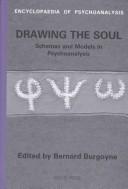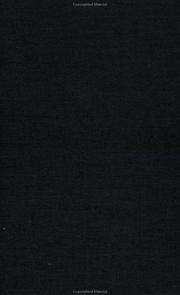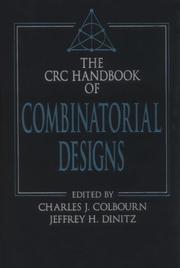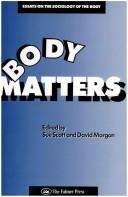| Listing 1 - 10 of 76 | << page >> |
Sort by
|

ISBN: 0429912951 042989872X 0429473958 1283125455 9786613125453 1849402825 9781849402828 9781900877251 1900877252 1855759039 9781855759039 Year: 2003 Publisher: London ; New York : Karnac Books,
Abstract | Keywords | Export | Availability | Bookmark
 Loading...
Loading...Choose an application
- Reference Manager
- EndNote
- RefWorks (Direct export to RefWorks)
At the beginning of each chapter in this collection is a reproduction of a classic psychoanalytic schema or model, ranging from Freud's first and second topographies, to Lacan's Schema ""L"". Each contributor uses the diagram as a means of elucidating the theory and practice of the respective schools of psychoanalysis.
Book
ISBN: 1784504505 9781784504502 9781785921797 1785921797 Year: 2017 Publisher: London Philadelphia
Abstract | Keywords | Export | Availability | Bookmark
 Loading...
Loading...Choose an application
- Reference Manager
- EndNote
- RefWorks (Direct export to RefWorks)
Observing and understanding schematic behaviour confidently is vital for anyone working with or looking after young children. This guide explains what schemas are, stripping back the technical language often used to describe them, and how to interpret and extend schematic behaviour to benefit the child. It looks specifically at 12 different schemas, such as connection, rotation and transportation, and includes case studies, interpretation of the observations and practical ideas for how to use this information to aid children's learning, development and play. Making schemas and schematic behaviour more understandable, this book will give early years practitioners and parents the confidence to identify schemas and plan future learning opportunities to support children based on this knowledge.
Book
ISBN: 9781108927475 1108927475 9781108918145 Year: 2023 Publisher: Cambridge, United Kingdom ;New York, NY Cambridge University Press
Abstract | Keywords | Export | Availability | Bookmark
 Loading...
Loading...Choose an application
- Reference Manager
- EndNote
- RefWorks (Direct export to RefWorks)
"An up-to-date guide to the practice of contemporary Schema Therapy. This book provides a practical, informative, and relevant psychotherapeutic approach and presents powerful techniques and cutting-edge developments of the model with step-by-step guidance and clinical examples. Highly relevant both to students and experienced practitioners"--
Book

ISSN: 03031179 ISBN: 9782856297902 Year: 2014 Publisher: Paris Société mathématique de France
Abstract | Keywords | Export | Availability | Bookmark
 Loading...
Loading...Choose an application
- Reference Manager
- EndNote
- RefWorks (Direct export to RefWorks)
Homology theory --- Schemes (Algebraic geometry) --- Cohomologie --- Schémas (géométrie algébrique) --- Cohomologie.

ISBN: 1135963991 0203906497 0203905253 1280316977 9780203906491 9780203905258 9780415915854 0415915856 9780415915861 0415915864 9786610316977 661031697X 9781135963996 9781280316975 9781135963941 9781135963989 1135963983 Year: 1999 Publisher: New York Routledge
Abstract | Keywords | Export | Availability | Bookmark
 Loading...
Loading...Choose an application
- Reference Manager
- EndNote
- RefWorks (Direct export to RefWorks)
This collection of essays defy arbitrary distinctions between nature and culture and reveal the complex ways in which nature and culture interact to produce embodied subjects.
Body image --- Body schema --- Body percept --- Percept, Body --- Schema, Body --- Schemas (Psychology) --- Somesthesia --- Image, Body --- Imagery (Psychology) --- Mind and body --- Person schemas --- Personality --- Self-perception --- Human body --- Congresses
Book
ISBN: 354007158X 038707158X 3540374868 9783540071587 Year: 1975 Volume: 455 Publisher: Berlin
Abstract | Keywords | Export | Availability | Bookmark
 Loading...
Loading...Choose an application
- Reference Manager
- EndNote
- RefWorks (Direct export to RefWorks)
Algebraic geometry --- Number theory --- 512 --- Algebra --- 512 Algebra --- Geometrie algebrique --- Schemas de groupes

ISBN: 0849389488 Year: 1996 Publisher: Boca Raton, FL : CRC Press,
Abstract | Keywords | Export | Availability | Bookmark
 Loading...
Loading...Choose an application
- Reference Manager
- EndNote
- RefWorks (Direct export to RefWorks)
Book
ISBN: 1350085286 1474257577 9781474257558 1474257550 9781474257572 9781474257565 1474257569 9781474257541 1474257542 Year: 2017 Publisher: London ; New York : Bloomsbury Academic,
Abstract | Keywords | Export | Availability | Bookmark
 Loading...
Loading...Choose an application
- Reference Manager
- EndNote
- RefWorks (Direct export to RefWorks)
" Providing a deeper understanding of how two-year-old children learn, Understanding Schematic Learning at Two highlights how a schematic pedagogy can be used to recognise and develop two-year-old children's thinking and understanding of the world around them. Over a 16-week period four children's individual experiences and stories are constructed, providing detailed written and photographic evidence of the unfolding schematic learning journeys of each. Following the children from nursery setting to home environment, readers gain a greater understanding of how, even at such a young age, children are intrinsically motivated to select resources from the environment to support their schematic thinking. The book focuses on the importance of needing an appropriate environment and pedagogy to support two-year-old children's schematic explorations and development and the significant role adults play in developing this. Beginning by highlighting the important links between learning opportunities, environment and the role of the adults, Brierley and Nutbrown trace the origins of schema and provide an overview of the definition and characteristics of schema. Chapters then go on to explore how the early years landscape has been influenced through a combination of research and government policy initiatives. Concluding that future focus must foreground how children learn, Understanding Schematic Learning at Two identifies how recognising and valuing young children's schemas provides adults with the opportunity and ability to acknowledge two-year-old children's capability to actively construct and develop an understanding of the world they live in. "-- "Provides a deeper understanding of how two-year-old children learn, recognising and foregrounding the role of schema"--
Book
ISSN: 1381589X ISBN: 9789027251985 9027251983 9781588116390 1588116395 9786612156694 1282156691 9027294402 9789027294401 Year: 2005 Volume: v. 62 Publisher: Amsterdam Benjamins
Abstract | Keywords | Export | Availability | Bookmark
 Loading...
Loading...Choose an application
- Reference Manager
- EndNote
- RefWorks (Direct export to RefWorks)
The body, as the common ground for objectivity and (inter)subjectivity, is a phenomenon with a perplexing plurality of registers. Therefore, this innovative volume offers an interdisciplinary approach from the fields of neuroscience, phenomenology and psychoanalysis. The concepts of body image and body schema have a firm tradition in each of these disciplines and make up the conceptual anchors of this volume.Challenged by neuropathological phenomena, neuroscience has dealt with body image and body schema since the beginning of the twentieth century. Halfway through the twentieth century, phenomenology was inspired by child development and elaborated a specifically phenomenological account of body image and schema. Starting from the mirror stage, this source of inspiration is shared with psychoanalysis which develops the concept of body image in interaction with the clinic of the singular subject. In this volume, the creative encounter of these three perspectives on the body opens up present-day paths for conceptualisation, research and (clinical) practice. (Series B).
Philosophical anthropology --- Body image. --- Body schema. --- Image du corps --- Schéma corporel --- Body percept --- Percept, Body --- Schema, Body --- Schemas (Psychology) --- Somesthesia --- Image, Body --- Imagery (Psychology) --- Mind and body --- Person schemas --- Personality --- Self-perception --- Human body

ISBN: 1850009430 1850009422 Year: 1993 Publisher: London Falmer
Abstract | Keywords | Export | Availability | Bookmark
 Loading...
Loading...Choose an application
- Reference Manager
- EndNote
- RefWorks (Direct export to RefWorks)
Sociology of the family. Sociology of sexuality --- Body image --- Human body --- Image du corps --- Corps humain --- Social aspects --- Aspect social --- 316.371 --- 392.6 --- 316.7 --- Gender --- Seksualiteit. Seksueel leven. Concubinaat. Samenwonen. Prostitutie. Erotiek. Seksuele gebruiken. Liefdeskunst --- Cultuursociologie --(algemeen) --- Body image. --- Person schemas. --- Social aspects. --- 316.7 Cultuursociologie --(algemeen) --- 392.6 Seksualiteit. Seksueel leven. Concubinaat. Samenwonen. Prostitutie. Erotiek. Seksuele gebruiken. Liefdeskunst --- 316.371 Gender --- Person schemas --- Enduring person schemas --- Schemas, Person --- Interpersonal relations --- Schemas (Psychology) --- Self psychology --- Image, Body --- Imagery (Psychology) --- Mind and body --- Personality --- Self-perception
| Listing 1 - 10 of 76 | << page >> |
Sort by
|

 Search
Search Feedback
Feedback About UniCat
About UniCat  Help
Help News
News